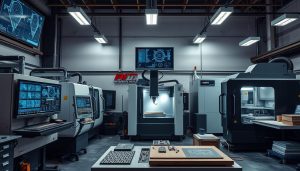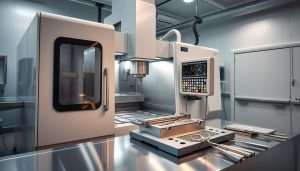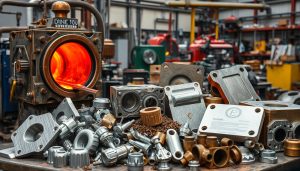In today’s manufacturing world, picking the right CNC machine is key to project success. CNC technology has changed how we make and shape products. But with CNC routers, mills, and lathes, how do you choose the right one for your needs? What are the main differences between these CNC machines, and how do you pick the best one for your project?
What is a CNC Router?
A CNC (Computer Numerical Control) router is a versatile tool that has changed woodworking and large-scale sheet material processing. These machines use computer technology to cut, carve, and shape materials like wood, plastic, aluminum, and composites.
How CNC Routers Operate
At the heart of a CNC router is a spindle with high-speed cutting tools, called bits or end mills. These tools move along multiple axes, making intricate cuts. The computer controls these movements, allowing for detailed designs and shapes with great accuracy and speed.
Best Uses: Woodworking and Large Sheets
CNC routers are key in woodworking machinery, making furniture, cabinetry, and architectural components quickly and accurately. They are also great for sheet material processing, cutting and shaping large panels of materials like plywood, MDF, and acrylic.
The speed and precision of CNC routers have made them a game-changer. They allow businesses and artisans to create complex designs and products easily and efficiently.
“CNC routers have become an indispensable tool in the modern woodworking and manufacturing industries, revolutionizing the way we approach complex projects and large-scale production.”
What is a CNC Mill?
A CNC (Computer Numerical Control) mill is a machine tool that uses computer control for precise movements. It shapes and produces complex parts and components. Unlike CNC routers, which are mainly for woodworking, CNC mills are great for metal fabrication and precision machining.
Overview of Milling Techniques
CNC milling uses rotating tools to remove material from a workpiece. This creates intricate shapes, grooves, and features. Techniques include face milling, end milling, and peripheral milling, each with its own uses.
- Face milling is good for removing a lot of material and making flat surfaces.
- End milling is for complex contours, pockets, and three-dimensional features.
- Peripheral milling is great for machining the sides and edges of a workpiece.
Ideal Applications: Complex Shapes and Metalwork
The precision and versatility of CNC mills make them perfect for many applications. They are especially good for making complex shapes and metal components. These machines are great for parts with tight tolerances, intricate geometries, and excellent surface finishes. They are very useful in aerospace, automotive, and medical device manufacturing.
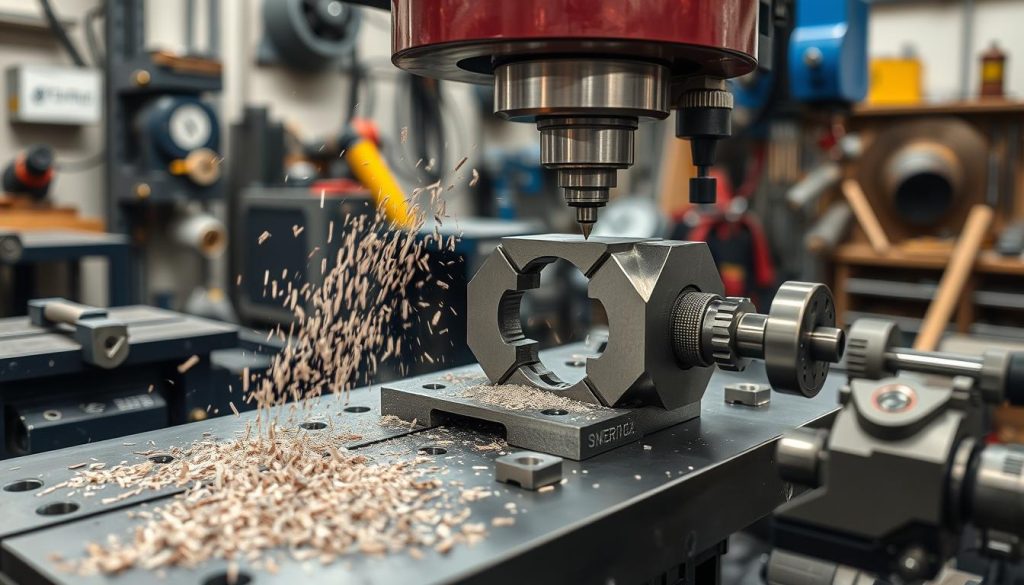
“CNC mills offer unparalleled precision and flexibility, empowering manufacturers to tackle the most demanding metalworking challenges with ease.”
What is a CNC Lathe?
In the world of computer numerical control (CNC) machining, the CNC lathe is a key tool. It’s great for making parts that are round and have rotational symmetry. Unlike CNC routers and mills, which make complex shapes, the CNC lathe is all about CNC turning. This means it’s perfect for cylindrical part production and rotational symmetry.
Lathe Operations and Mechanisms
A CNC lathe holds a workpiece in place and spins it fast. As it turns, a cutting tool moves to shape the part. This method lets makers add details like grooves and threads with great accuracy.
Best for Cylindrical and Rotational Parts
- CNC lathes are top-notch for making round parts, from simple shafts to complex engine parts.
- Its spinning motion is perfect for parts with rotational symmetry, ensuring they’re always the same.
- Car, plane, and manufacturing industries count on CNC lathes for their cylindrical part production needs.
“The CNC lathe is an indispensable tool in the modern manufacturing landscape, offering unparalleled precision and versatility in the creation of cylindrical and rotationally symmetric parts.”
Using CNC lathes helps manufacturers make their work faster and better. They can create high-quality parts that meet strict standards.
Key Differences Between CNC Routers, Mills, and Lathes
Choosing between CNC routers, mills, and lathes affects your manufacturing process and product quality. Knowing the differences is key to improving manufacturing efficiency and material processing.
Speed and Precision Comparison
CNC routers work fast, perfect for making lots of parts. CNC mills focus on precision, giving tighter tolerances and smoother finishes. CNC lathes offer a mix of speed and precision, ideal for round parts.
Material Compatibility and Strength
CNC routers can work with many materials, like wood and plastics. CNC mills are best for metals. CNC lathes can handle both hard and soft materials well.
Design Flexibility and Volume Capabilities
CNC mills are great for making complex shapes. CNC routers are best for big projects and lots of parts. CNC lathes are good for round parts and simple to complex designs.
| Feature | CNC Router | CNC Mill | CNC Lathe |
|---|---|---|---|
| Speed | High | Moderate | Moderate |
| Precision | Moderate | High | Moderate |
| Material Compatibility | Wood, Plastics | Metals | Versatile (Hard and Soft Materials) |
| Design Flexibility | Large-scale, High-volume | Complex, Intricate Shapes | Cylindrical, Simple to Moderately Complex |
Understanding CNC routers, mills, and lathes helps manufacturers choose the right machine. This choice affects manufacturing efficiency and material processing capabilities.
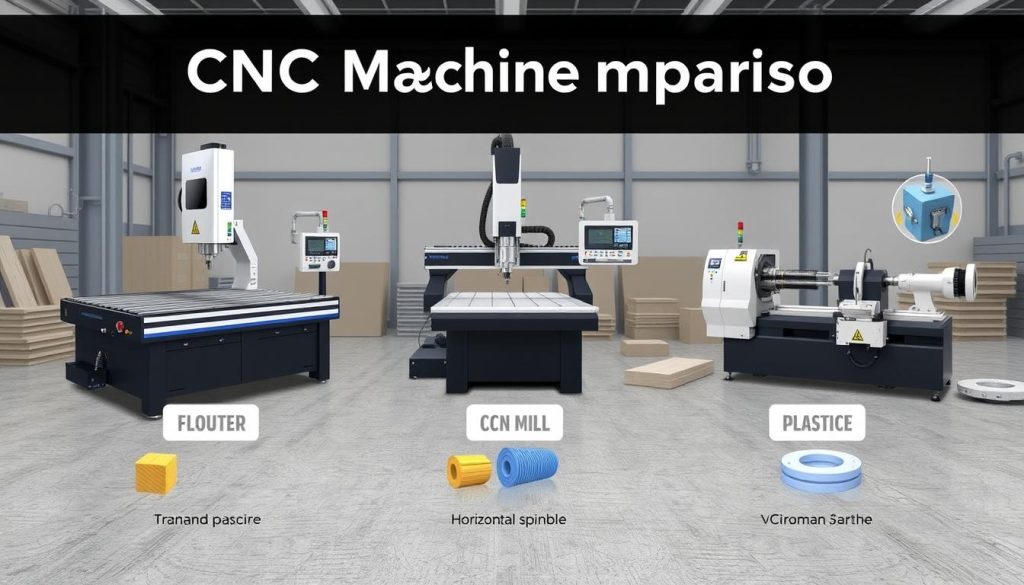
Choosing the Right Machine for Your Project
Choosing the right CNC machine is crucial for your project. You need to think about your budget, the materials you’ll use, and how complex your project is. This can seem overwhelming, but by focusing on these key points, you can find the best machine for your needs. It will help you get the results you want without spending too much.
Factors to Consider
To pick the right CNC machine, consider these important factors:
- Budget: Start by setting a budget for your CNC machine. Know how much you can spend and look for machines that fit within your budget. This way, you can find a machine that’s affordable yet still meets your needs.
- Material Requirements: Think about the materials you’ll be working with. Different machines are better for different materials. Make sure the machine you choose can handle the materials you need for your project.
- Project Complexity: Look at how complex your project is. Consider the level of detail, the need for intricate shapes, and how many pieces you’ll be making. This will help you find a machine with the right features and precision for your project.
By carefully looking at these factors, you can make a smart choice. This choice will match your CNC machine selection with your project requirements and keep costs down.
Shixinproto’s CNC Solutions
At Shixinproto, we’re proud to offer a wide range of CNC services. Our clients need precision CNC milling, intricate CNC turning, or large-scale CNC routing. Our skilled engineers and technicians are ready to meet your needs.
Comprehensive Services for CNC Milling, Turning, and Routing
We use the latest CNC machining for many applications. This includes making complex metal parts and cutting large materials. Our focus on quality and efficiency means we deliver custom solutions that impress our clients.
Why Shixinproto Stands Out in CNC Precision
Our success comes from our dedication to precision engineering. We use our CNC expertise to make parts and components with exacting standards. This ensures every project gets the perfect fit and finish.
Our attention to detail and quality control make us the top choice for CNC services. Businesses trust us for reliable and accurate work.

